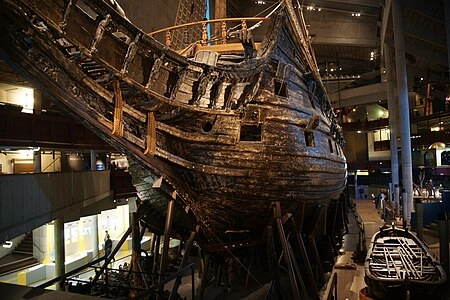(Automated translation. The original article can be found here : https://longterme.org/2023/09/le-syndrome-du-vasa-fluctuat-et-mergitur.html)
When it was inaugurated in 1628, the Vasa was the most beautiful ship of its time, decorated with magnificent sculptures and capable of accommodating 64 cannons and 300 soldiers on board. It was the pride of Sweden, which had devoted more than 5% of its GDP to its construction – equivalent to thirty nuclear submarines for France in 2023. But the Vasa sank on its maiden voyage, just one mile from Stockholm’s port, taking dozens of sailors with it. Miraculously preserved in the icy waters of the Baltic Sea, its wreck is an invaluable source of information for historians. But it also inspires all those interested in the challenges of large complex projects.
While the trial following the sinking sought to find a responsible party without success, historians have identified several typical causes of such projects, collectively known as the « Vasa syndrome. » The first is the ignorance of technical limitations. Shipbuilding at the time was not based on calculations but on the reproduction of previous ship models, and the impact of modifications to plans was poorly understood. With current methods, it is obvious that the center of gravity was too high and would cause the ship to capsize. The second cause is a radical modification due to the « Prince’s decree. » When presented with the initial drafts, the King requested the addition of a row of cannons, which is the source of the ship’s balance problem. Despite the probable doubts of architects, unable to anticipate the impact of such a modification. Third, the desire to please the sponsors: tests carried out before the inauguration clearly showed a stability problem that was ignored on the grounds that the architect had already built other ships. Similarly, the maiden voyage took place with the cannons exposed to show the power of the ship, instead of closing the hatches that would have slowed the sinking. Fourth, the confusion of objectives: excessive resources were devoted to decoration to make the ship an object of pride at the expense of the main objective – floating. Fifth, a weakness in project management: the right profile for this type of role is not a person seeking consensus, but a professional capable of an uncompromising diagnosis, of speaking the truth, and focused enough to keep an eye on priority objectives. The death of the architect during the project did not help, as he was replaced by someone less able to resist pressure. Sixth, a mismatch between ambitions and means: excessive pressure on the schedule did not allow time for proper design. However, design weaknesses or lack of testing that are accepted to meet the schedule, and which are thought to be caught up in production, generally tend to amplify as the project progresses. Seventh cause: communication problems. First between those in charge – the King, the architect, and the shipyard had visions that were never reconciled. Then within the shipyard, notably with the use of rulers graduated in feet of 11 inches by some and 12 by others.
The development of digital technology makes some of these lessons obsolete: no one would undertake such a project without testing and simulation. But it also brings new risks: a large IT project is a Vasa in itself. Digital technology can also amplify existing problems: Conway’s law predicts that an IT project reproduces the communication defects of the organization that designs it. Finally, IT can create a feeling of excessive confidence: few managers consider themselves to master naval architecture, while more numerous are those who express themselves on digital matters with a level of confidence higher than their level of technological mastery.
The other lessons of the Vasa are eternal, and the museum dedicated to it in Stockholm – one of the most popular attractions in Europe – inspires history enthusiasts and organizational science researchers alike.
